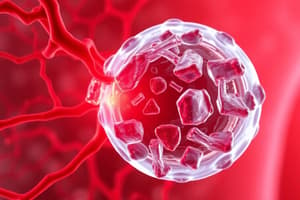Podcast
Questions and Answers
Begins immediately after injury.
Characterized by increased blood flow, swelling, redness and heat.
Begins immediately after injury. Characterized by increased blood flow, swelling, redness and heat.
- Inflammatory phase (correct)
- Debridement phase
- Repair/regeneration phase
- Maturation phase
Occurs approximately 6 hours after injury.
Pus may accumulate, composed of WBCs.
Crucial phase.
Occurs approximately 6 hours after injury. Pus may accumulate, composed of WBCs. Crucial phase.
- Inflammatory phase
- Debridement phase (correct)
- Repair/regeneration phase
- Maturation phase
Begins 3-5 days post injury.
Fibroblasts invade the area, forming granulation tissue.
Begins 3-5 days post injury. Fibroblasts invade the area, forming granulation tissue.
- Inflammatory phase
- Debridement phase
- Repair/regeneration phase (correct)
- Maturation phase
Begins about 3 weeks after injury.
Characterized by collagen remodeling and a slow gain in wound strength
Begins about 3 weeks after injury. Characterized by collagen remodeling and a slow gain in wound strength
Characteristics of a wound
Characteristics of a wound
Types of healing
Types of healing
Aspects of managing
Aspects of managing
Layers of bandages
Layers of bandages
Specific wound care
Specific wound care
Match
Match
Types of bandages
Types of bandages
Used for hip luxation reduction
Used for hip luxation reduction
Immobilizes the scapula and prevents weight-bearing on the forelimb
Immobilizes the scapula and prevents weight-bearing on the forelimb
Wound healing begins immediately after insult
Wound healing begins immediately after insult
This response is the bodies attempt to limit the damage caused by the injury, to isolate the injury, and prevent more damage from occurring
This response is the bodies attempt to limit the damage caused by the injury, to isolate the injury, and prevent more damage from occurring
The inflammatory response is the same whether it is an injury or a disease
The inflammatory response is the same whether it is an injury or a disease
Wound healing is sustained by the release of growth factors from multiple cell types
Wound healing is sustained by the release of growth factors from multiple cell types
Characterized by the remolding of the collagen of the scar and slow gain in wound strength
Characterized by the remolding of the collagen of the scar and slow gain in wound strength
The process by which organisms bind to tissue, multiply, then invade viable tissue
The process by which organisms bind to tissue, multiply, then invade viable tissue
Simplest and most economical
Simplest and most economical
Helps hold skin grafts to granulation wound bed
Helps hold skin grafts to granulation wound bed
Wound with a questionable blood supply should remain closed until the extent of the nonviable tissue is determined
Wound with a questionable blood supply should remain closed until the extent of the nonviable tissue is determined
Tape, elastic tape, vetwrap
Tape, elastic tape, vetwrap
Gauze wrap (kling, conform), cast padding
Gauze wrap (kling, conform), cast padding
Adherent bandages and 1 nonadherent
Adherent bandages and 1 nonadherent
Casts-fiberglass cast routinely used because they are light weight, rigidity rapid setting time, ventilation and waterproof properties
Casts-fiberglass cast routinely used because they are light weight, rigidity rapid setting time, ventilation and waterproof properties
Most commonly used for immobilization of fractures distal to the elbow or stifle before surgery
Most commonly used for immobilization of fractures distal to the elbow or stifle before surgery
Used to reduce post swelling, cast padding is used. Thoracic or abdominal bandages are applied firmly but without constriction
Used to reduce post swelling, cast padding is used. Thoracic or abdominal bandages are applied firmly but without constriction
Used for temporary immobilization; used for distal fractures of the radius/ulna, phalanges and metacarpal , metatarsal bones
Used for temporary immobilization; used for distal fractures of the radius/ulna, phalanges and metacarpal , metatarsal bones
Used for closed fractures of the radius/ulna or tibia/fibula
Used for closed fractures of the radius/ulna or tibia/fibula
Used specifically for craniodorsal coxofemoral luxation and to prevent wgt bearing after surgery on the pelvis (immobilize the hindlimb)
Used specifically for craniodorsal coxofemoral luxation and to prevent wgt bearing after surgery on the pelvis (immobilize the hindlimb)
Places the flexed forelimb against the chest and prevents movement in all joints
Places the flexed forelimb against the chest and prevents movement in all joints



